#sorry if the image IDs are clunky
Text


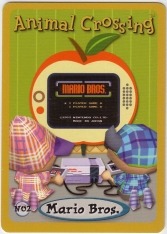
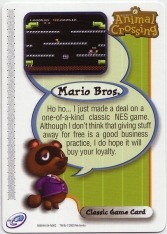
animal crossing (nintendo gamecube)
e-reader cards that can be scanned for in-game playable NES system furniture items, featuring the games "ice climber" and "mario bros"
#animal crossing#gamecube#nintendo#retro gaming#retro#nostalgia#acgc#tom nook#NES#e-reader#gameboy#gba#sorry if the image IDs are clunky#this was the highest res of these i could find that were credited 💀
63 notes
·
View notes
Text
For posterity, Tumblr’s April Fools 2023
- You can add little emoji reactions to posts!

[ID: Screenshot of the bottom of a tumblr post, to show the interactive button present. At the start of the row for the “sharing”, “reply”, “reblog”, and “like” buttons, there is a new button shaped like a simple smiley face in the monochrome tumblr style. End ID]
Complete overview with screenshots under the cut! Everything saved except moving visuals and audio elements (they’re described though!)
- There’s 7 base reactions: bug, cheese, crab, four (this one’s noisy), ghost, horse (this one’s noisy), and socks

[ID: Screenshot of the bottom of a tumblr post. The smiley face is clicked on and a small menu showing the described emojis is attached under it. End ID.]
(Hovering over them causes a small black speech bubble to appear above them, saying the words transcripted above, in lowercase. The parenthesis for horse and four are included in their respective bubbles.)
- You can add them to the post in whichever order you’d like (reblogs seem to reorganize them though, in another order than the one shown above), and they’ll appear without any number on them. Once you’ve clicked on them once, they’ll count two clicks.
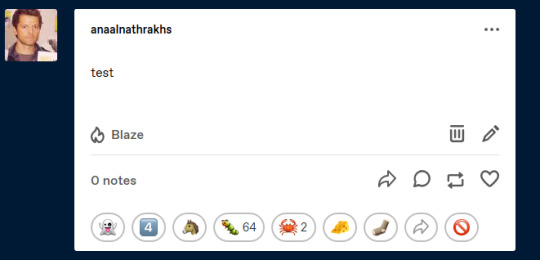
[ID: Screenshot of a tumblr post by yours truly saying “test”. It shows under the row of notes and “reblog”, “like”, etc buttons a row of the described emojis in simple oval delimitations. They’re in a different order than the one used for the menu. The bubble for the bug emoji includes the number 64 and the bubble for the crab includes the number 2. End ID.]
- Clicking on a reaction multiple times in a row makes a black circle appear above it with the number of clicks written on it. The number progresses as you click more as long as there's not significant interruption and the bubble grows with each click. I can only assume it has a maximum size and it unlocks something, but i've gone up to roughly 1700 in one go and i don't want to figure out autoclickers so somebody else is gonna have to find that out.

[ID: Screenshot of a post saying “test”. Some emojis reaction are shown under it, and a black circle with the number 62 in it, large enough to reach the top of the usual buttons row, is shown above the bug emoji. End ID.]
- It also activates the effects of each reaction.
- Bug does nothing but backflips, and stops at 70 458, the amount of votes it got in the original bug race poll
- Crab dances side to side and stops at 1000
- 4 makes speech bubbles written 4 appear. Various voices saying the word four in different languages play after about a dozen clicks, all of them very whispery, except one, saying four in a very casual tone. It stops at 444

[ID: Another test post showing the emoji 4 with the number 367 in its button. Blue speech bubbles with the number 4 written in it are shown clustered all over the post interface, blocking it from view. End ID.]
- Ghost makes post go progressively transparent and stops at 666
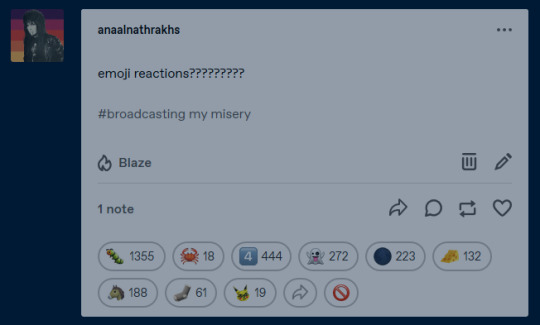
[ID: Screenshot of a post by yours truly saying “emoji reactions” with several interrogation points, showing multiple emoji reactions at the bottom, including the ghost one with the number 272 next to it. The whole post, including the user’s icon, is lower opacity than other screenshots and looks greyed out in comparison. End ID.]
- Cheese makes melted cheese appear on the top and bottom of your post and stops at 100 000

[ID: The same post, showing multiple emoji reactions, including the cheese one with the number 132 next to it. On the top and bottom edge of the post, varying drawings of melting yellow cheese are clustered, probably around 130 though they overlap too much to count. End ID.]
- Horse makes the horsie go (circular motion as a running horse would move) and plays galloping sounds. It stops at 500
- Sock makes green stink lines appear on your post and rise up until they fade away, stops at 1000

[ID: The same post, showing reactions including the sock emoji one. Squiggly green vertical lines in various opacities are shown over the post’s interface and text. End ID.]
- Maxing out a reaction or using it a certain number of times makes bonus reactions appear. Here’s all of them in one picture, all of them maxed out (at least the humanly possible ones)

[ID: A screenshot of the used reactions interface that shows up under a post. The crab emoji shows the number 1000. The ghost emoji shows 666. The cheese emoji shows 1228. The 4 emoji shows 444. The socks emoji shows 1000. Horse shows 500. Bug shows 3334. The next emoji is a picture of a bottle of vanilla extract, and shows 999. The next emoji is a drawing that ressembles a Pikachu with somewhat human proportions and glasses, it shows 19. The next emoji is a unicorn emoji showing 7. The next emoji shows the moon in its “new” phase, darked out, with the number 223. The next emoji is a cookie, showing 999. The next emoji is a drawing of a bust wearing a business suit and having a brick for a head. It shows no number. In two similar bubbles after that, the usual “share” button and the universal “no” red sign are shown. End ID.]
- Moon appears when you max out 4 and stops at 223
- Vanilla appears when clicking a lot on the crab (over 100 times?) and stops at 999
- Pikaman appears for some mysterious reason idk, jump and loops when you hover over it, stops at 19. After further investigation, it seems to either have multiple different but very convoluted ways to summon it, or to simply be on a randomizer. I still don’t have autoclick, sue me. After further explaining from the brick himself, Pikaman allgedly appears after a certain number of bug reactions. Either this number is inconsistent or another randomized action/combination of factors is needed to activate Pikaman.
- Unicorn appears when you max out the horse reaction, jumps and loops like pikaman, and stops at 7
- Cookie appears when you click a lot (over 100?) on the vanilla and stops at 999
- Brick appears either when everything is maxed out and both bug and cheese have hit 1000 or when you combo 1000 clicks in a row (on bug or cheese likely but might be achievable on crab or sock), is unclickable
- When you hit the maximum of a reaction on a streak, a message signed by
Brick appears to tell you you can't go further
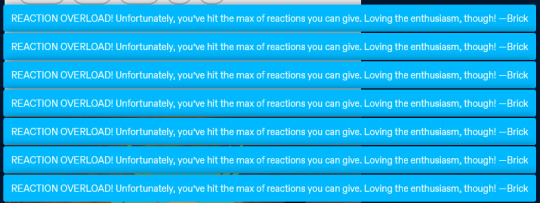
[ID: A screenshot of several popup messages on tumblr. All of them say “REACTION OVERLOAD! Unfortunately, you’re hit the max of reactions you can give. Loving the enthusiasm, though! - Brick”. End ID.]
- I have somehow gotten an error message signed by Brick. No idea how to replicate it. Editing after further testing, it seems to appear when the movement of the emoji makes clicking it impossible (the no symbol being visible) despite the maximum number not being reached.

[ID: An error popup message from tumblr, saying “Oh no. This is not working! But hey, I’m working on it! -Brick”. End ID.]
- The share button gives you a reblogging page with a generated image representing the reactions used on it and their corresponding numbers over a rainbow gradient background, as well as a little flavor text tagging @brickwhartley and two automatic tags. You’re free to modify this reblog though, and you can back out of the page.
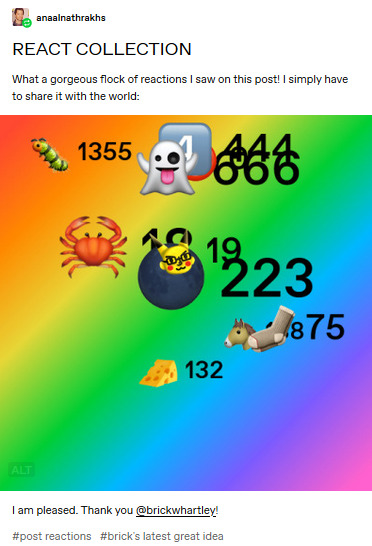
[ID: A screenshot of a reblog by myself. Text reads: “REACT COLLECTION” in bigger letters, as a title. Next paragraph reads: “What a gorgeous flock of reactions I saw on this post! I simply have to share it with the world:”. Under it is a picture of several emojis from the available reactions of various sizes in random places of the image, floating next to numbers over a rainbow gradient background. Text under the image reads: “I am please. Thank you @brickwhartley!”. Under it, two tags are show, “#post reactions” and “#birck’s latest great idea”. End ID.]
- The no symbol only appears on your own posts and allows you to disable reactions. It will appear next to the usual “share” “reply” “reblog” “like” icons and you can click on it to reverse it.
TL;DR this was made up by manufacturers to sell more computer mouses. Hope you don’t have completionist tendencies. My hand hurts.
#post reactions#brick's latest great idea#april fools#tumblr's april fools 2023#april fools 2023#i don't know why but this thing triggered both the need to 100% it#and the archivist panic to make sure i recorded everything and nobody will miss out any information#10/10 experience i had a stressful morning and i needed to count some stuff to feel better#broadcasting my misery#sorry the image ID was a little late i thought i'd try editing it in with the new interface to make it less clunky#since the legacy editor isn't great at effects#but it doesn't work on my post so fuck it it's gonna be clunky#also put back an image i forgot
167 notes
·
View notes
Text
sorry for being inactive i’m busy doing exams and a huge project that’s going to be continuing until april 28th
in the meantime: here’s a few questions
- what’s a trademark of my art style that you notice?
- do you have a favourite piece of mine?
- for people who read image ids: do you think my image ids are too long or clunky? i’m trying to get better at writing them, so having some feedback would be nice.
#not art#a huge thank you to iceemperor (previously hailstormshipping) who reblogged so much of my old art#that’s honestly the main reason i’m asking these questions. nostalgic for my old stuff#also if anyone remembers me discussing a transcendent zine/art book:#that’s still happening but it’s just going really slow.
4 notes
·
View notes
Photo
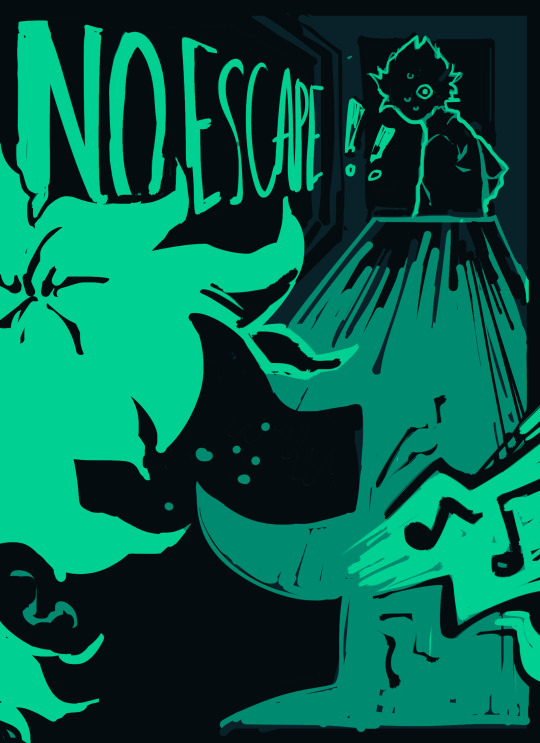
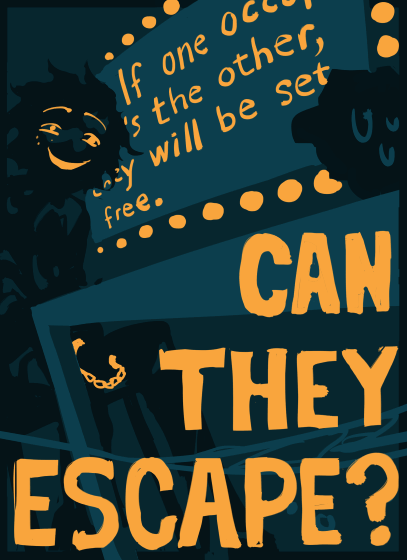


wanted to make poster-style drawings for just the two of us (we can make it if we try) by ijustwanttodestroy, @i-just-want-to-destroy on tumblr
image ids + images without text + extra stuff i wanted to say
[image id:
a series of illustrations with limited palletes in hues of teal, mint, and orange in a style attempting to resemble linocut printmaking.
image 1: in various shades of dark teal with mint. in the foreground, deku laughs, lilting and musical, as shinsou looks on, petrified, with his hand on the doorknob. a monitor on the side of the room reads NO ESCAPE ! !
image 2: in various shades of dark teal with bright orange. at one end of a table is someone's sweaty, clenched hand, and at the other is deku, his eyes creased and his grin a crescent moon. beside them, a monitor reads, "If one [occupant kills] the other, [they] will be set free." some text is blocked. superimposed above the table and the rising water, garish block text reading "CAN THEY ESCAPE?" in bright orange takes up the lower half of the image.
image 3: in various shades of teal. shinsou, his hair drenched, looks with a pallid, dear-in-headlights expression down at something indescipherable. one arm is defensively poised in front of him. there is seawater drizzling down from above, and large block text reading "TRAITOR" is superimposed on the middle of the image, with smaller, handwritten sans serif below it reading, "You've been sticking your nose where it doesn't belong, Detective-san!"
image 4: in various shades of teal. shinsou and deku's heads are barely above the rising water, gasping for breath. shinsou's hands are loosely holding onto deku's shoulders and deku's hands are desperately clenched on his. large block text imposed near the bottom of the page reads, "LAST-MINUTE" and below that, in cursive serif font wobbling slightly like a wave, "Confess every regret you'll never make better.”
image id end.]
things i wanted to say:
sorry for being so cringe i felt like the little philosophers in the cave making this because i couldnt actually find any refs for the style of printmade movie poster i want so i went from what id scrapped together in my head so im sure this looks kind of like . derivative? and boring i tried to kind of satirize (?) it but i dont think it worked.
i really liked the fic. the words were swag and the plot was yolo, etc. its my favorite worldbuilding ive ever seen in bnha fic which is maybe a weird thing to look for in bnha fanfic given that i dont think the worldbuilding of bnha, the manga is very good but i liked it a loooot & the reveals were so well done & the characters so well written . . . & just the vibes of an ocean locked room mystery type deal with a larger , darker plot . . . ! please read it if you havent
let me know if the image descriptions can be written in a less clunky/better way. like actually send me your image descs i want to get better at this
now that im done with this im going to stop thinking about bnha, hopefully.
here are some no-text versions:


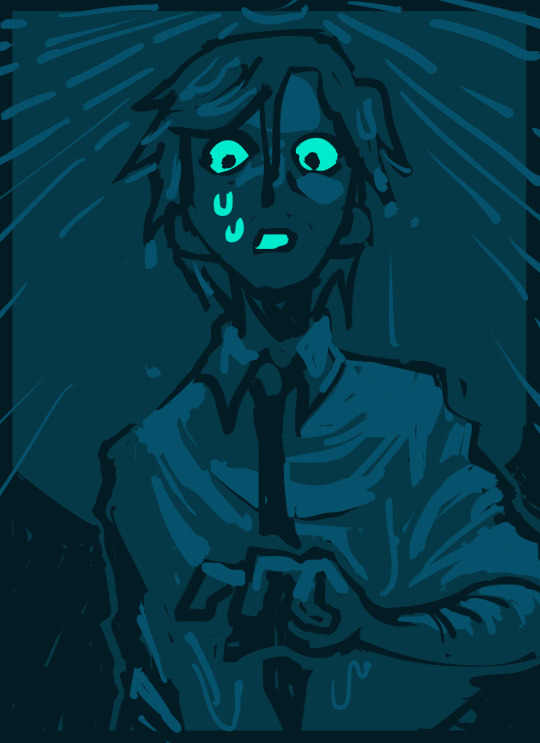
thank you
#bnha#midoriya izuku#shinsou hitoshi#i promise i am done thinking about bnha. [literally about to read more bnha fanfic]#my art
333 notes
·
View notes
Note
pspspsps screen readers are really clunky with "read more"s so if you put image ids under them it kind of defeats the purpose
Oh sorry, I just don't want to take up people's tl with long descriptions :/ would it be better if I removed the read more and used the font that makes the text smaller? Or would that also mess with a screen reader?
15 notes
·
View notes
Note
sorry for the bother, saw a post of yours that said you found out how to auto-generate the coli images for dragons? could you explain how? no pressure!! i just wanna spruce up my spreadsheet :0
yeah, np! I added it in one of my later reblogs, but that can be hard to find lol. The actual url for these images looks like this:
http://flightrising.com/rendern/coliseum/portraits/286232/28623142.png
Where the last number is the dragon’s ID, and the first number is the ID minus the last two digits, plus 1. (Similar to how the little square avatars are generated!) The code to get the images into your spreadsheets looks like this:
=IMAGE(concatenate(“http://flightrising.com/rendern/coliseum/portraits/”,CEILING((D2+1)/100),“/”,D2,“.png”))
If you wanted to generate BBCode to go in dragon bios, it would look like this:
=concatenate(“[url=http://flightrising.com/main.php?dragon=”,D2,“][img]http://flightrising.com/rendern/coliseum/portraits/”,CEILING((D2+1)/100),“/”,D2,“.png[/img][/url]”)
Edit, brief addition: D2 is where I pasted my dragon’s ID, you can change that to be whatever you need. You should only have to type the code out once, and then you can click + drag down the column to make all the images for all your dragons! If you’re working on a lore spreadsheet and the IDs look too clunky, you can always just hide the column once you’re done.
And word of warning, you’re going to want to type that all out into your Excel, instead of copying and pasting directly from this post. Something about Tumblr’s formatting confuses poor Excel, which is expecting plaintext. I have no idea why, but it’s popped up in the past, so. just so you know.
Hope that helps! o/
#dunno how much you know about Excel haha#so i added a bit more info just in case anyone is unfamiliar!#i'm not a Spreadsheet Expert or anything (am making it up as i go) but hopefully this is a helpful lil tutorial#zero answers
14 notes
·
View notes
Text
Pros and Cons of Top Social Media Advertising Platforms
Whether you’re a small business looking for inexpensive options to add to your marketing mix, or a big brand trying to determine which platforms will give you the best return on your dollar, it’s important to be aware of the benefits and downsides to each of the major social media channels available today. While return on ad spend is generally high for social, your business should determine whether a platform is the right fit before making the decision to spend. To help with your consideration, I’ve compiled a list of the pros and cons for each of the top social platforms offering advertising services today.
source: joemartinezsem.com
Facebook: 2 Billion Active Monthly Users
Pros of Facebook
Affordable: On Facebook, you can spend as much or as little as you want according to your budget and goals, making it ideal for small and big businesses alike.
Easy to Learn and Use: Facebook Ads are self-service, and there is a wealth of information available to new advertisers through Facebook Blueprint courses. Seriously, there is a course for just about every subject.
Microtargeting: On Facebook you can target users based on demographic information such as age, gender, location, and language, as well as detailed interests and behavioral targeting to reach the large Facebook audience in a highly segmented way.
Wide Audience: Again, Facebook has 2 Billion active monthly users, and they span across ages and demographics. If you want the widest reach for social, Facebook is where to put your ad spend.
Retargeting: The Facebook Pixel allows you to track user actions once they interact with your ad. This allows you to get valuable insights as well as retarget to consumers who have taken any number of valuable actions on your site.
Lookalike Audiences: My favorite thing about Facebook Ads is the ability to target an audience that looks like users who were valuable to you in some way. Do you want to find brand new users who are most likely to download your whitepaper? Create a lookalike audience to find people similar to those who have already downloaded it.
Cons of Facebook
Diminished Organic Reach: Marketers are notices a sharp decline in their organic reach, and based on Facebook’s new NewsFeed algorithm changes, this trend is likely to continue. This means that reaching your audience will require more ad spend, and less attention to organic page post engagement.
(Potentially) Lower Quality Leads: While this depends entirely on your strategy, advertisers who are not yet adept at Facebook Ads may not know that optimizing for link clicks leads to Facebook serving your ads to “clicky” consumers who may not actually care about your product or service.
Time-Intensive: To keep frequency and reach in check, and to avoid ad fatigue, Facebook advertising requires constant monitoring and ad refreshes to give your business the best shot at success on the platform. If you don’t have the time to dedicate to this, you may not see the best possible results.
Creative Considerations: Simple text ads like you can utilize with Google AdWords don’t cut it in Facebook; creative is visual with a focus on video and mobile optimization. Having good creative resources is essential for success with Facebook advertising.
#DeleteFacebook: While we don’t believe that Facebook users are going anywhere to any significant degree, some brands have expressed concern over Facebook controversies throughout the first half of 2018.
Instagram: “A Captivated Community”
Pros of Instagram
Visual Focus: Instagram ads are meant to be visually appealing to captivate your audience. High-quality photos and videos grab user attention and promote positive brand awareness.
Detailed Targeting: Instagram has the same hyper-focused targeting capabilities as Facebook (and Instagram is owned by Facebook, in case you did not know). This means you can reach just the right user for your product, and tailor your messaging to their interests.
Shopping/Collections: Especially important for retail and e-commerce, Instagram allows you to group a collection of products together, or to inform users of the products highlighted in a photo or video in your ad. You can give the user a Call-to-Action to encourage purchases launched from within the app.
Engagement: Instagram is a personal, conversational, and engaging platform. Engagement rates are 10 times higher than Facebook, 54 times higher than Pinterest, and 84 times higher than Twitter.
Cons of Instagram
Limited Audience: Instagram has a much younger user base, with 90% of users younger than 35 years old. This is great for certain brands like fashion lines, but not as good for anyone with a much older target persona.
Minimal Text Copy: Because captivating photos and videos are the focus in Instagram, any text-heavy images or extra lengthy copy are not going to do well on this platform.
Time-Intensive: Like Facebook, staying fresh and relevant, as well as engaging with users, requires a lot of time and effort compared to search platforms like AdWords. An in-house advertiser who is responsible for all channels will probably not be able to devote as much time as they’ll need in learning as well as production.
Diminished Organic Reach: Businesses are seeing the same trend for Instagram feeds as in Facebook, naturally. Organic reach is steadily declining, causing paid efforts to rise and become the priority.
LinkedIn: The World’s Largest Professional Network
Pros of LinkedIn
Valuable Audience & Detailed Targeting: B2B customers will find their perfect audience on LinkedIn. Its user base is largely business professionals, and the targeting options are specific and related to users’ professions. Target based on salary, job title, employer, company size, etc. An approach that mimics an ABM strategy works well for my clients on LinkedIn.
Higher Lead Quality: It’s easy to reach top decision-makers on LinkedIn. You can even specifically target C-suite users. Member demos like income and job responsibility skew higher for LinkedIn than for the other platforms.
Selve-Serve: If you have a LinkedIn account, you can easily create an ad account for your business and utilize the self-serve options according to your advertising goals.
Varied Ad Formats: You can utilize text ads similar to what you find in AdWords, or you can take a content marketing approach and sponsor content such as blog posts to share with the top-of-funnel audience you’re after. There are also display ads, lead generation forms, and video ads to choose from.
Cons of LinkedIn
Higher CPCs/CPAs: getting quality clicks or leads is great, but it does come at a higher cost for LinkedIn compared to come other social platforms.
“Clunky” Platform: This is a matter of opinion, but I find the platform to be a bit unwieldy compared to other platforms. There is a lot of clicking around required to make changes.
Limited Learning Resources: Compared to Facebook, LinkedIn has nowhere near the level of educational resources available to new advertisers. There are FAQs and Help sections, but I find myself wanting coursework akin to the Facebook Blueprint syllabus.
Not Ideal for E-commerce: Because there are no product ads, and because LinkedIn users are expecting a personal and professional experience when they use the site, LinkedIn is not the best platform for E-commerce businesses.
Twitter: Let Your Audience Know What’s Happening
Pros of Twitter
Large Audience: Twitter boasts of over 330 million active monthly users, meaning you can engage with a large (and varied) audience. Take a look at Twitter member stats to get an idea of the potential audience available to reach. Custom audiences built around your followers, competitors followers, or user interests are a key benefit of Twitter ads.
Keyword Targeting: Unlike the other major social media advertising platforms discussed here, Twitter allows you to reach users who have recently tweeted or searched for terms you include in your campaign targeting.
Conversational: Twitter allows for real-time delivery of messages, and fosters engagement with mentions and communication between users. Brands can have active dialogues with their audience.
Global Reach: 79% of Twitter users are outside the U.S.
Scheduled Tweets: Stay engaged even when you’re off the clock by scheduling promoted tweets to run at predetermined times. This helps lessen some of the “time-intensiveness” that is inherent to face-paced social platforms.
Cons of Twitter
Fast-Paced: Users tweet by-the-minute updates, so the fleeting nature of messages in the feed means that brands are more likely to go unnoticed on Twitter compared to other platforms.
Limited Messaging: Only 140 characters means that messages have to be brief. Shortened URLs do give you the ability to link to longer content hosted elsewhere, though.
Time-Intensive: Because Twitter is fast-paced, success on the platform requires dedication of time and resources to stay relevant, fresh, and visible amidst the constant stream of new content into the feed.
User Perception: Users are more likely to see sponsored/promoted tweets as spam. There have also been instances where brands fail at fitting in on the platform, which means you’re often better safe than sorry when it comes to hopping on hashtag bandwagons or finding your voice on a trending topic.
Final Thoughts
Chances are your business already has a presence on some of these platforms, but you may not be utilizing the paid advertising services they offer. Hopefully this list was a good start in considering which paid services are right for your organization’s needs. Ready to start and looking for more specific information? Visit the Social Topics page for more blogs on all things social!
from RSSMix.com Mix ID 8217493 https://www.ppchero.com/pros-and-cons-of-top-social-media-advertising-platforms/
0 notes
Text
Pros and Cons of Top Social Media Advertising Platforms
Whether you’re a small business looking for inexpensive options to add to your marketing mix, or a big brand trying to determine which platforms will give you the best return on your dollar, it’s important to be aware of the benefits and downsides to each of the major social media channels available today. While return on ad spend is generally high for social, your business should determine whether a platform is the right fit before making the decision to spend. To help with your consideration, I’ve compiled a list of the pros and cons for each of the top social platforms offering advertising services today.
source: joemartinezsem.com
Facebook: 2 Billion Active Monthly Users
Pros of Facebook
Affordable: On Facebook, you can spend as much or as little as you want according to your budget and goals, making it ideal for small and big businesses alike.
Easy to Learn and Use: Facebook Ads are self-service, and there is a wealth of information available to new advertisers through Facebook Blueprint courses. Seriously, there is a course for just about every subject.
Microtargeting: On Facebook you can target users based on demographic information such as age, gender, location, and language, as well as detailed interests and behavioral targeting to reach the large Facebook audience in a highly segmented way.
Wide Audience: Again, Facebook has 2 Billion active monthly users, and they span across ages and demographics. If you want the widest reach for social, Facebook is where to put your ad spend.
Retargeting: The Facebook Pixel allows you to track user actions once they interact with your ad. This allows you to get valuable insights as well as retarget to consumers who have taken any number of valuable actions on your site.
Lookalike Audiences: My favorite thing about Facebook Ads is the ability to target an audience that looks like users who were valuable to you in some way. Do you want to find brand new users who are most likely to download your whitepaper? Create a lookalike audience to find people similar to those who have already downloaded it.
Cons of Facebook
Diminished Organic Reach: Marketers are notices a sharp decline in their organic reach, and based on Facebook’s new NewsFeed algorithm changes, this trend is likely to continue. This means that reaching your audience will require more ad spend, and less attention to organic page post engagement.
(Potentially) Lower Quality Leads: While this depends entirely on your strategy, advertisers who are not yet adept at Facebook Ads may not know that optimizing for link clicks leads to Facebook serving your ads to “clicky” consumers who may not actually care about your product or service.
Time-Intensive: To keep frequency and reach in check, and to avoid ad fatigue, Facebook advertising requires constant monitoring and ad refreshes to give your business the best shot at success on the platform. If you don’t have the time to dedicate to this, you may not see the best possible results.
Creative Considerations: Simple text ads like you can utilize with Google AdWords don’t cut it in Facebook; creative is visual with a focus on video and mobile optimization. Having good creative resources is essential for success with Facebook advertising.
#DeleteFacebook: While we don’t believe that Facebook users are going anywhere to any significant degree, some brands have expressed concern over Facebook controversies throughout the first half of 2018.
Instagram: “A Captivated Community”
Pros of Instagram
Visual Focus: Instagram ads are meant to be visually appealing to captivate your audience. High-quality photos and videos grab user attention and promote positive brand awareness.
Detailed Targeting: Instagram has the same hyper-focused targeting capabilities as Facebook (and Instagram is owned by Facebook, in case you did not know). This means you can reach just the right user for your product, and tailor your messaging to their interests.
Shopping/Collections: Especially important for retail and e-commerce, Instagram allows you to group a collection of products together, or to inform users of the products highlighted in a photo or video in your ad. You can give the user a Call-to-Action to encourage purchases launched from within the app.
Engagement: Instagram is a personal, conversational, and engaging platform. Engagement rates are 10 times higher than Facebook, 54 times higher than Pinterest, and 84 times higher than Twitter.
Cons of Instagram
Limited Audience: Instagram has a much younger user base, with 90% of users younger than 35 years old. This is great for certain brands like fashion lines, but not as good for anyone with a much older target persona.
Minimal Text Copy: Because captivating photos and videos are the focus in Instagram, any text-heavy images or extra lengthy copy are not going to do well on this platform.
Time-Intensive: Like Facebook, staying fresh and relevant, as well as engaging with users, requires a lot of time and effort compared to search platforms like AdWords. An in-house advertiser who is responsible for all channels will probably not be able to devote as much time as they’ll need in learning as well as production.
Diminished Organic Reach: Businesses are seeing the same trend for Instagram feeds as in Facebook, naturally. Organic reach is steadily declining, causing paid efforts to rise and become the priority.
LinkedIn: The World’s Largest Professional Network
Pros of LinkedIn
Valuable Audience & Detailed Targeting: B2B customers will find their perfect audience on LinkedIn. Its user base is largely business professionals, and the targeting options are specific and related to users’ professions. Target based on salary, job title, employer, company size, etc. An approach that mimics an ABM strategy works well for my clients on LinkedIn.
Higher Lead Quality: It’s easy to reach top decision-makers on LinkedIn. You can even specifically target C-suite users. Member demos like income and job responsibility skew higher for LinkedIn than for the other platforms.
Selve-Serve: If you have a LinkedIn account, you can easily create an ad account for your business and utilize the self-serve options according to your advertising goals.
Varied Ad Formats: You can utilize text ads similar to what you find in AdWords, or you can take a content marketing approach and sponsor content such as blog posts to share with the top-of-funnel audience you’re after. There are also display ads, lead generation forms, and video ads to choose from.
Cons of LinkedIn
Higher CPCs/CPAs: getting quality clicks or leads is great, but it does come at a higher cost for LinkedIn compared to come other social platforms.
“Clunky” Platform: This is a matter of opinion, but I find the platform to be a bit unwieldy compared to other platforms. There is a lot of clicking around required to make changes.
Limited Learning Resources: Compared to Facebook, LinkedIn has nowhere near the level of educational resources available to new advertisers. There are FAQs and Help sections, but I find myself wanting coursework akin to the Facebook Blueprint syllabus.
Not Ideal for E-commerce: Because there are no product ads, and because LinkedIn users are expecting a personal and professional experience when they use the site, LinkedIn is not the best platform for E-commerce businesses.
Twitter: Let Your Audience Know What’s Happening
Pros of Twitter
Large Audience: Twitter boasts of over 330 million active monthly users, meaning you can engage with a large (and varied) audience. Take a look at Twitter member stats to get an idea of the potential audience available to reach. Custom audiences built around your followers, competitors followers, or user interests are a key benefit of Twitter ads.
Keyword Targeting: Unlike the other major social media advertising platforms discussed here, Twitter allows you to reach users who have recently tweeted or searched for terms you include in your campaign targeting.
Conversational: Twitter allows for real-time delivery of messages, and fosters engagement with mentions and communication between users. Brands can have active dialogues with their audience.
Global Reach: 79% of Twitter users are outside the U.S.
Scheduled Tweets: Stay engaged even when you’re off the clock by scheduling promoted tweets to run at predetermined times. This helps lessen some of the “time-intensiveness” that is inherent to face-paced social platforms.
Cons of Twitter
Fast-Paced: Users tweet by-the-minute updates, so the fleeting nature of messages in the feed means that brands are more likely to go unnoticed on Twitter compared to other platforms.
Limited Messaging: Only 140 characters means that messages have to be brief. Shortened URLs do give you the ability to link to longer content hosted elsewhere, though.
Time-Intensive: Because Twitter is fast-paced, success on the platform requires dedication of time and resources to stay relevant, fresh, and visible amidst the constant stream of new content into the feed.
User Perception: Users are more likely to see sponsored/promoted tweets as spam. There have also been instances where brands fail at fitting in on the platform, which means you’re often better safe than sorry when it comes to hopping on hashtag bandwagons or finding your voice on a trending topic.
Final Thoughts
Chances are your business already has a presence on some of these platforms, but you may not be utilizing the paid advertising services they offer. Hopefully this list was a good start in considering which paid services are right for your organization’s needs. Ready to start and looking for more specific information? Visit the Social Topics page for more blogs on all things social!
from RSSMix.com Mix ID 8217493 https://www.ppchero.com/pros-and-cons-of-top-social-media-advertising-platforms/
0 notes
Text
Pros and Cons of Top Social Media Advertising Platforms
Whether you’re a small business looking for inexpensive options to add to your marketing mix, or a big brand trying to determine which platforms will give you the best return on your dollar, it’s important to be aware of the benefits and downsides to each of the major social media channels available today. While return on ad spend is generally high for social, your business should determine whether a platform is the right fit before making the decision to spend. To help with your consideration, I’ve compiled a list of the pros and cons for each of the top social platforms offering advertising services today.
source: joemartinezsem.com
Facebook: 2 Billion Active Monthly Users
Pros of Facebook
Affordable: On Facebook, you can spend as much or as little as you want according to your budget and goals, making it ideal for small and big businesses alike.
Easy to Learn and Use: Facebook Ads are self-service, and there is a wealth of information available to new advertisers through Facebook Blueprint courses. Seriously, there is a course for just about every subject.
Microtargeting: On Facebook you can target users based on demographic information such as age, gender, location, and language, as well as detailed interests and behavioral targeting to reach the large Facebook audience in a highly segmented way.
Wide Audience: Again, Facebook has 2 Billion active monthly users, and they span across ages and demographics. If you want the widest reach for social, Facebook is where to put your ad spend.
Retargeting: The Facebook Pixel allows you to track user actions once they interact with your ad. This allows you to get valuable insights as well as retarget to consumers who have taken any number of valuable actions on your site.
Lookalike Audiences: My favorite thing about Facebook Ads is the ability to target an audience that looks like users who were valuable to you in some way. Do you want to find brand new users who are most likely to download your whitepaper? Create a lookalike audience to find people similar to those who have already downloaded it.
Cons of Facebook
Diminished Organic Reach: Marketers are notices a sharp decline in their organic reach, and based on Facebook’s new NewsFeed algorithm changes, this trend is likely to continue. This means that reaching your audience will require more ad spend, and less attention to organic page post engagement.
(Potentially) Lower Quality Leads: While this depends entirely on your strategy, advertisers who are not yet adept at Facebook Ads may not know that optimizing for link clicks leads to Facebook serving your ads to “clicky” consumers who may not actually care about your product or service.
Time-Intensive: To keep frequency and reach in check, and to avoid ad fatigue, Facebook advertising requires constant monitoring and ad refreshes to give your business the best shot at success on the platform. If you don’t have the time to dedicate to this, you may not see the best possible results.
Creative Considerations: Simple text ads like you can utilize with Google AdWords don’t cut it in Facebook; creative is visual with a focus on video and mobile optimization. Having good creative resources is essential for success with Facebook advertising.
#DeleteFacebook: While we don’t believe that Facebook users are going anywhere to any significant degree, some brands have expressed concern over Facebook controversies throughout the first half of 2018.
Instagram: “A Captivated Community”
Pros of Instagram
Visual Focus: Instagram ads are meant to be visually appealing to captivate your audience. High-quality photos and videos grab user attention and promote positive brand awareness.
Detailed Targeting: Instagram has the same hyper-focused targeting capabilities as Facebook (and Instagram is owned by Facebook, in case you did not know). This means you can reach just the right user for your product, and tailor your messaging to their interests.
Shopping/Collections: Especially important for retail and e-commerce, Instagram allows you to group a collection of products together, or to inform users of the products highlighted in a photo or video in your ad. You can give the user a Call-to-Action to encourage purchases launched from within the app.
Engagement: Instagram is a personal, conversational, and engaging platform. Engagement rates are 10 times higher than Facebook, 54 times higher than Pinterest, and 84 times higher than Twitter.
Cons of Instagram
Limited Audience: Instagram has a much younger user base, with 90% of users younger than 35 years old. This is great for certain brands like fashion lines, but not as good for anyone with a much older target persona.
Minimal Text Copy: Because captivating photos and videos are the focus in Instagram, any text-heavy images or extra lengthy copy are not going to do well on this platform.
Time-Intensive: Like Facebook, staying fresh and relevant, as well as engaging with users, requires a lot of time and effort compared to search platforms like AdWords. An in-house advertiser who is responsible for all channels will probably not be able to devote as much time as they’ll need in learning as well as production.
Diminished Organic Reach: Businesses are seeing the same trend for Instagram feeds as in Facebook, naturally. Organic reach is steadily declining, causing paid efforts to rise and become the priority.
LinkedIn: The World’s Largest Professional Network
Pros of LinkedIn
Valuable Audience & Detailed Targeting: B2B customers will find their perfect audience on LinkedIn. Its user base is largely business professionals, and the targeting options are specific and related to users’ professions. Target based on salary, job title, employer, company size, etc. An approach that mimics an ABM strategy works well for my clients on LinkedIn.
Higher Lead Quality: It’s easy to reach top decision-makers on LinkedIn. You can even specifically target C-suite users. Member demos like income and job responsibility skew higher for LinkedIn than for the other platforms.
Selve-Serve: If you have a LinkedIn account, you can easily create an ad account for your business and utilize the self-serve options according to your advertising goals.
Varied Ad Formats: You can utilize text ads similar to what you find in AdWords, or you can take a content marketing approach and sponsor content such as blog posts to share with the top-of-funnel audience you’re after. There are also display ads, lead generation forms, and video ads to choose from.
Cons of LinkedIn
Higher CPCs/CPAs: getting quality clicks or leads is great, but it does come at a higher cost for LinkedIn compared to come other social platforms.
“Clunky” Platform: This is a matter of opinion, but I find the platform to be a bit unwieldy compared to other platforms. There is a lot of clicking around required to make changes.
Limited Learning Resources: Compared to Facebook, LinkedIn has nowhere near the level of educational resources available to new advertisers. There are FAQs and Help sections, but I find myself wanting coursework akin to the Facebook Blueprint syllabus.
Not Ideal for E-commerce: Because there are no product ads, and because LinkedIn users are expecting a personal and professional experience when they use the site, LinkedIn is not the best platform for E-commerce businesses.
Twitter: Let Your Audience Know What’s Happening
Pros of Twitter
Large Audience: Twitter boasts of over 330 million active monthly users, meaning you can engage with a large (and varied) audience. Take a look at Twitter member stats to get an idea of the potential audience available to reach. Custom audiences built around your followers, competitors followers, or user interests are a key benefit of Twitter ads.
Keyword Targeting: Unlike the other major social media advertising platforms discussed here, Twitter allows you to reach users who have recently tweeted or searched for terms you include in your campaign targeting.
Conversational: Twitter allows for real-time delivery of messages, and fosters engagement with mentions and communication between users. Brands can have active dialogues with their audience.
Global Reach: 79% of Twitter users are outside the U.S.
Scheduled Tweets: Stay engaged even when you’re off the clock by scheduling promoted tweets to run at predetermined times. This helps lessen some of the “time-intensiveness” that is inherent to face-paced social platforms.
Cons of Twitter
Fast-Paced: Users tweet by-the-minute updates, so the fleeting nature of messages in the feed means that brands are more likely to go unnoticed on Twitter compared to other platforms.
Limited Messaging: Only 140 characters means that messages have to be brief. Shortened URLs do give you the ability to link to longer content hosted elsewhere, though.
Time-Intensive: Because Twitter is fast-paced, success on the platform requires dedication of time and resources to stay relevant, fresh, and visible amidst the constant stream of new content into the feed.
User Perception: Users are more likely to see sponsored/promoted tweets as spam. There have also been instances where brands fail at fitting in on the platform, which means you’re often better safe than sorry when it comes to hopping on hashtag bandwagons or finding your voice on a trending topic.
Final Thoughts
Chances are your business already has a presence on some of these platforms, but you may not be utilizing the paid advertising services they offer. Hopefully this list was a good start in considering which paid services are right for your organization’s needs. Ready to start and looking for more specific information? Visit the Social Topics page for more blogs on all things social!
from RSSMix.com Mix ID 8217493 https://www.ppchero.com/pros-and-cons-of-top-social-media-advertising-platforms/
0 notes
Text
Pros and Cons of Top Social Media Advertising Platforms
Whether you’re a small business looking for inexpensive options to add to your marketing mix, or a big brand trying to determine which platforms will give you the best return on your dollar, it’s important to be aware of the benefits and downsides to each of the major social media channels available today. While return on ad spend is generally high for social, your business should determine whether a platform is the right fit before making the decision to spend. To help with your consideration, I’ve compiled a list of the pros and cons for each of the top social platforms offering advertising services today.
source: joemartinezsem.com
Facebook: 2 Billion Active Monthly Users
Pros of Facebook
Affordable: On Facebook, you can spend as much or as little as you want according to your budget and goals, making it ideal for small and big businesses alike.
Easy to Learn and Use: Facebook Ads are self-service, and there is a wealth of information available to new advertisers through Facebook Blueprint courses. Seriously, there is a course for just about every subject.
Microtargeting: On Facebook you can target users based on demographic information such as age, gender, location, and language, as well as detailed interests and behavioral targeting to reach the large Facebook audience in a highly segmented way.
Wide Audience: Again, Facebook has 2 Billion active monthly users, and they span across ages and demographics. If you want the widest reach for social, Facebook is where to put your ad spend.
Retargeting: The Facebook Pixel allows you to track user actions once they interact with your ad. This allows you to get valuable insights as well as retarget to consumers who have taken any number of valuable actions on your site.
Lookalike Audiences: My favorite thing about Facebook Ads is the ability to target an audience that looks like users who were valuable to you in some way. Do you want to find brand new users who are most likely to download your whitepaper? Create a lookalike audience to find people similar to those who have already downloaded it.
Cons of Facebook
Diminished Organic Reach: Marketers are notices a sharp decline in their organic reach, and based on Facebook’s new NewsFeed algorithm changes, this trend is likely to continue. This means that reaching your audience will require more ad spend, and less attention to organic page post engagement.
(Potentially) Lower Quality Leads: While this depends entirely on your strategy, advertisers who are not yet adept at Facebook Ads may not know that optimizing for link clicks leads to Facebook serving your ads to “clicky” consumers who may not actually care about your product or service.
Time-Intensive: To keep frequency and reach in check, and to avoid ad fatigue, Facebook advertising requires constant monitoring and ad refreshes to give your business the best shot at success on the platform. If you don’t have the time to dedicate to this, you may not see the best possible results.
Creative Considerations: Simple text ads like you can utilize with Google AdWords don’t cut it in Facebook; creative is visual with a focus on video and mobile optimization. Having good creative resources is essential for success with Facebook advertising.
#DeleteFacebook: While we don’t believe that Facebook users are going anywhere to any significant degree, some brands have expressed concern over Facebook controversies throughout the first half of 2018.
Instagram: “A Captivated Community”
Pros of Instagram
Visual Focus: Instagram ads are meant to be visually appealing to captivate your audience. High-quality photos and videos grab user attention and promote positive brand awareness.
Detailed Targeting: Instagram has the same hyper-focused targeting capabilities as Facebook (and Instagram is owned by Facebook, in case you did not know). This means you can reach just the right user for your product, and tailor your messaging to their interests.
Shopping/Collections: Especially important for retail and e-commerce, Instagram allows you to group a collection of products together, or to inform users of the products highlighted in a photo or video in your ad. You can give the user a Call-to-Action to encourage purchases launched from within the app.
Engagement: Instagram is a personal, conversational, and engaging platform. Engagement rates are 10 times higher than Facebook, 54 times higher than Pinterest, and 84 times higher than Twitter.
Cons of Instagram
Limited Audience: Instagram has a much younger user base, with 90% of users younger than 35 years old. This is great for certain brands like fashion lines, but not as good for anyone with a much older target persona.
Minimal Text Copy: Because captivating photos and videos are the focus in Instagram, any text-heavy images or extra lengthy copy are not going to do well on this platform.
Time-Intensive: Like Facebook, staying fresh and relevant, as well as engaging with users, requires a lot of time and effort compared to search platforms like AdWords. An in-house advertiser who is responsible for all channels will probably not be able to devote as much time as they’ll need in learning as well as production.
Diminished Organic Reach: Businesses are seeing the same trend for Instagram feeds as in Facebook, naturally. Organic reach is steadily declining, causing paid efforts to rise and become the priority.
LinkedIn: The World’s Largest Professional Network
Pros of LinkedIn
Valuable Audience & Detailed Targeting: B2B customers will find their perfect audience on LinkedIn. Its user base is largely business professionals, and the targeting options are specific and related to users’ professions. Target based on salary, job title, employer, company size, etc. An approach that mimics an ABM strategy works well for my clients on LinkedIn.
Higher Lead Quality: It’s easy to reach top decision-makers on LinkedIn. You can even specifically target C-suite users. Member demos like income and job responsibility skew higher for LinkedIn than for the other platforms.
Selve-Serve: If you have a LinkedIn account, you can easily create an ad account for your business and utilize the self-serve options according to your advertising goals.
Varied Ad Formats: You can utilize text ads similar to what you find in AdWords, or you can take a content marketing approach and sponsor content such as blog posts to share with the top-of-funnel audience you’re after. There are also display ads, lead generation forms, and video ads to choose from.
Cons of LinkedIn
Higher CPCs/CPAs: getting quality clicks or leads is great, but it does come at a higher cost for LinkedIn compared to come other social platforms.
“Clunky” Platform: This is a matter of opinion, but I find the platform to be a bit unwieldy compared to other platforms. There is a lot of clicking around required to make changes.
Limited Learning Resources: Compared to Facebook, LinkedIn has nowhere near the level of educational resources available to new advertisers. There are FAQs and Help sections, but I find myself wanting coursework akin to the Facebook Blueprint syllabus.
Not Ideal for E-commerce: Because there are no product ads, and because LinkedIn users are expecting a personal and professional experience when they use the site, LinkedIn is not the best platform for E-commerce businesses.
Twitter: Let Your Audience Know What’s Happening
Pros of Twitter
Large Audience: Twitter boasts of over 330 million active monthly users, meaning you can engage with a large (and varied) audience. Take a look at Twitter member stats to get an idea of the potential audience available to reach. Custom audiences built around your followers, competitors followers, or user interests are a key benefit of Twitter ads.
Keyword Targeting: Unlike the other major social media advertising platforms discussed here, Twitter allows you to reach users who have recently tweeted or searched for terms you include in your campaign targeting.
Conversational: Twitter allows for real-time delivery of messages, and fosters engagement with mentions and communication between users. Brands can have active dialogues with their audience.
Global Reach: 79% of Twitter users are outside the U.S.
Scheduled Tweets: Stay engaged even when you’re off the clock by scheduling promoted tweets to run at predetermined times. This helps lessen some of the “time-intensiveness” that is inherent to face-paced social platforms.
Cons of Twitter
Fast-Paced: Users tweet by-the-minute updates, so the fleeting nature of messages in the feed means that brands are more likely to go unnoticed on Twitter compared to other platforms.
Limited Messaging: Only 140 characters means that messages have to be brief. Shortened URLs do give you the ability to link to longer content hosted elsewhere, though.
Time-Intensive: Because Twitter is fast-paced, success on the platform requires dedication of time and resources to stay relevant, fresh, and visible amidst the constant stream of new content into the feed.
User Perception: Users are more likely to see sponsored/promoted tweets as spam. There have also been instances where brands fail at fitting in on the platform, which means you’re often better safe than sorry when it comes to hopping on hashtag bandwagons or finding your voice on a trending topic.
Final Thoughts
Chances are your business already has a presence on some of these platforms, but you may not be utilizing the paid advertising services they offer. Hopefully this list was a good start in considering which paid services are right for your organization’s needs. Ready to start and looking for more specific information? Visit the Social Topics page for more blogs on all things social!
from RSSMix.com Mix ID 8217493 https://www.ppchero.com/pros-and-cons-of-top-social-media-advertising-platforms/
0 notes